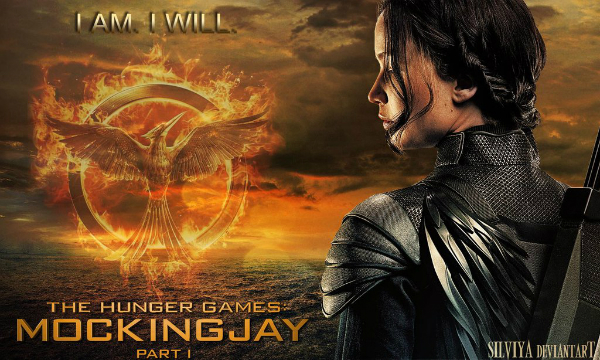Written by Amanda Rodriguez.
Mild Spoilers Ahead
First off, let’s get the unpleasant part out of the way. Serious fans of The Hunger Games series will likely hate me, but we’ve all got to face the truth. The third installment in the series, The Hunger Games: Mockingjay Part I should not have been made. Splitting movies into two parts is an ever-growing trend in Hollywood’s never-ending quest for more money. Over the course of the two-hour film, not enough happens to warrant its existence. There is little moving the plot forward, and the ending itself is anticlimactic as our heroine Katniss Everdeen (Jennifer Lawrence) isn’t even involved in the ultimately uneventful final showdown mission to rescue the captive tributes. The vital events that do happen in Part I could have easily been condensed into the first 20 minutes of the finale of a legitimate trilogy.
With that out of the way, let’s talk about what does work in Mockingjay Part I. There are a lot of women involved in the film itself, from the writer of the novels, Suzanne Collins, who adapted her books for the screen, to Nina Jacobson, the producer of the entire series, to our tenacious heroine Katniss, played by the increasingly popular, amazing performer and feminist Jennifer Lawrence.
I particularly liked that Mockingjay Part I also sets up the opposition between patriarchy and matriarchy with the introduction of Julianne Moore as President Coin of District 13. Under the patriarchal tyranny of President Snow (Donald Sutherland), the districts of Panem suffer as the people are used for their labor and their districts’ resources while fear and capital punishment are the norm. His Capitol, however, is rich, fashion-obsessed, and completely self-serving. The matriarchal President Coin, on the other hand, represents revolution with a strict focus on democracy and a socialist emphasis on the sharing of resources. District 13 is a militaristic, utilitarian underground compound that eschews fashion in favor of function (as evinced by the monotone uniforms all residents wear). Those of us who have read the books know that a lot will shift before the series concludes, but for now, this embodiment of a nontraditional representation of matriarchy in Coin is refreshing. She is decisive, smart, calm when under attack, and always thinking about the greater good of the people.
While watching Mockingjay Part I, I had an epiphany. I asked myself why Katniss Everdeen is such a compelling heroine to audiences and why other heroines modeled after her are popping up all over the place? There’s no denying that audiences (especially young women) are hungry for strong female representation on screen. We love to see Katniss use her wits and her bow to save the day, but in Mockingjay Part I, there is very little action (Katniss uses her bow only once), and Jennifer Lawrence’s performance is still riveting. Why, do you think, that is?
Two words for you: emotional range. While there are a plethora of limitations and stereotypes by which female characters are plagued, audiences are getting tired of the limited range of emotion that male heroes are allowed to exhibit due to the strictness of masculinity within our culture. Women are increasingly allowed to showcase a greater range of emotions without it damaging their perception as a strong, good leader.
In Mockingjay Part I, Katniss is suffering from intense PTSD. She has flashbacks, night terrors, uncontrollable bouts of crying, and dissociates from her surroundings. Throughout the film, she is an emotional wreck, as she should be after what she’s gone through, from being hunted and forced to kill for sport, to having her home of District 12 genocided as a result of her actions.
We watch Katniss go through an emotional roller coaster as she experiences shock, horror, terror, guilt, sadness, loss, anger, grief, and devastation. She is overcome with love for her family, Gale, and Peta, and, at her core, we are the most compelled by Katniss’ compassion and her instinctual drive to protect others. Katniss is sometimes wrong and often rash in her actions. In truth, it is her vulnerability displayed on screen like a raw wound from which we cannot look away.
This is the stuff of heroes. We see her experiences nearly break her time and time again, but she won’t give up. Carrying on is so hard that it nearly destroys her, but her sense of what is right is so strong that she cannot turn her back on her fellow oppressed district dwellers.
Like Katniss is the symbol of revolution as the mockingjay, she’s also the symbol of a movement that values women as nonsexualized leads with rich, complex characterization. We’re increasingly bored with the stoic male hero and instead crave the strength and vulnerability of the growing number of female sci-fi action heroines that are emerging thanks to the success of Katniss Everdeen and The Hunger Games.
Aside: The United States IS the Capitol. The storyline of The Hunger Games is so popular in the US, but we’re missing the point if we don’t confess that we are the oppressive world superpower that tyrannizes the rest of the word, exploiting the labor and resources of others so that most of us can live in relative wealth and comfort. End rant.
Bitch Flicks writer and editor Amanda Rodriguez is an environmental activist living in Asheville, North Carolina. She holds a BA from Antioch College in Yellow Springs, Ohio and an MFA in fiction writing from Queens University in Charlotte, NC. Her short story “The Woman Who Fell in Love with a Mermaid” was published in Germ Magazine. She writes all about food and drinking games on her blog Booze and Baking. Fun fact: while living in Kyoto, Japan, her house was attacked by monkeys.








